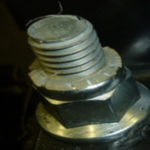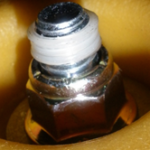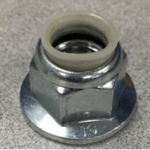If you use nylon insert lock nuts in production, it is more than likely that you have run into some issues like the ones pictured below:



Causes
Why does this happen, and usually only in January through March?
The inserts are made of 66 nylon which is hydroscopic, meaning it can absorb moisture up to 8% of its weight. When exposed to temperature extremes and low humidity, the nylon will lose moisture and can shrink slightly and in some cases become brittle. These conditions are not relevant once the insert is installed, but if the nylon has become too dry prior to assembly, then we can see problems like those pictured above.
Certain assembly conditions can contribute to failure of a dried out insert, such as:
• Poor or no chamfer on mating threads
• Long thread engagement
• High assembly speed
• Any combination of the above conditions
If the insert is very dry and brittle, and the mating thread has a poor chamfer, we can see breaking of the nylon, especially if the assembly speed is very fast as with an impact gun.
Long thread engagements coupled with high speeds seem to heat-up the dried out nylon enough to cause it to extrude out the top of the nut. This can happen with properly hydrated nylon as well, especially if the pitch diameter of the mating thread is at the upper end of tolerance (the nylon has to go someplace) but it seems to happen more when the nylon is dried out.
In extreme cases of dried out inserts, such as those run through a bake oven for some type of post finish (zinc flake for example), the inserts may spin freely in their cavity prior to installation. When the mating part is introduced, some inserts may be pushed out of the nut without even forming threads into the nylon ring.
Solutions
- Packaging/environment
- Wherever possible, keep nuts sealed in their original containers until they are ready to be consumed.
- Do not store more nuts than needed in extreme cold and/or dry environments.
- Assembly
- Check for chamfers on mating parts – a smooth entry into the nylon will lessen potential problems.
- Avoid long thread engagement if possible.
- If not possible, adjust speed down to lessen heat build-up.
- Check speed of assembly – try slowing down the speed if problems occur.
- Additional Insert Material
- If these solutions do not resolve the issues, then consider another type of insert material.
- High temperature materials are available that are not as sensitive to environment.
For questions, please contact our Engineering team at ProvenProductivity@Bossard.com.
For more shopping options click here.
Doug Jones
Applications Engineer
djones@bossard.com




